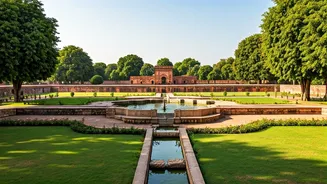A Garden's Legacy
The Mughal Gardens in India stand as remarkable testaments to a bygone era, reflecting the artistic sensibilities and architectural prowess of the Mughal Empire.
These gardens were not merely places of leisure; they were carefully designed spaces that embodied the concept of paradise, a reflection of the Islamic ideal of a heavenly garden. These gardens seamlessly blend Persian influences with local Indian traditions, resulting in unique landscapes that are admired across the globe. Each garden tells its own story, exhibiting the distinct tastes and preferences of the emperors who commissioned them. These gardens are meticulously planned, incorporating elements like flowing water, symmetrical layouts, and lush vegetation to create an immersive experience. They serve as tangible links to the past, reminding us of the rich history and cultural heritage of India.
Shalimar Bagh, Srinagar
Nestled in the heart of Srinagar, Shalimar Bagh is a captivating Mughal Garden that once served as a royal retreat. Established by Emperor Jahangir for his beloved wife, Nur Jahan, this garden is a true masterpiece of Mughal landscape architecture. Its design showcases the characteristic symmetry and the use of terraces, with water channels flowing through the center, adding to its allure. The garden's name, Shalimar, which translates to 'abode of love,' reflects the emotional significance and purpose it held for the emperor and his queen. Each level of the garden offers a different perspective and experience, with the uppermost terrace serving as the location of the Diwan-e-Aam, or the Hall of Public Audience. Its vibrant flowers, strategic water features, and well-maintained pathways make it a must-visit destination. The exquisite views and tranquil atmosphere provide an unforgettable experience for visitors.
Nishat Bagh's Serenity
Nishat Bagh, meaning 'Garden of Delight,' is another jewel in the crown of Srinagar's Mughal Gardens, crafted by Asaf Khan, the brother of Empress Nur Jahan. It presents an innovative design that elegantly slopes down towards the Dal Lake, offering breathtaking views. The garden's layout emphasizes the importance of visual perspective, using terraces to amplify the impact of the views. The garden's layout is meticulously planned, with each level showcasing a different perspective and creating a distinct experience. The central water channel, flanked by rows of trees and vibrant flowerbeds, draws the eye down towards the lake, blending the landscape with the water. Nishat Bagh is celebrated not just for its beauty but also for the harmony between nature and architecture. This harmony perfectly reflects the Mughal aesthetic principles that value balance, symmetry, and a strong connection with the natural environment.
Humayun's Tomb Garden
In Delhi, the Humayun's Tomb Garden offers a glimpse into the earlier phase of Mughal garden design. This garden surrounds the tomb of Emperor Humayun, establishing a model for future Mughal garden layouts in India. The tomb itself is a stunning display of Mughal architecture. Its charbagh design, which divides the garden into four quadrants by walkways and water channels, is an integral element of the landscape. The symmetry and the orderly arrangement create a sense of harmony and peace, embodying the Mughal ideal of paradise. The garden's layout enhances the beauty of the tomb, offering several viewpoints that highlight its architectural details and the overall aesthetic. Visiting this garden provides a glimpse into the genesis of the Mughal garden concept and its impact on Indian architecture and landscape design.
Taj Mahal Gardens
The gardens surrounding the Taj Mahal, also located in Agra, are among the most famous examples of Mughal landscape design globally. Built by Emperor Shah Jahan in memory of his wife Mumtaz Mahal, the Taj Mahal and its gardens represent an enduring symbol of love. The charbagh layout is crucial to the design, aligning precisely with the mausoleum to create a striking visual symmetry. Water channels, lined with cypress trees and flowers, guide the eye towards the central structure, intensifying the focus on the Taj Mahal. The meticulous detailing of the gardens, from the selection of plants to the arrangement of pathways, further enhances the overall beauty of the complex. The Taj Mahal gardens perfectly capture the grandeur and elegance of the Mughal Empire. This iconic site has become a lasting monument to love and architectural ingenuity.
Other Notable Gardens
Besides the well-known gardens, various other Mughal gardens across India enrich the country's cultural tapestry. The Pinjore Gardens in Haryana showcase a blend of Mughal and Rajasthani architectural elements. The Ram Bagh in Agra, one of the earliest Mughal gardens in India, holds significant historical value. The Mehtab Bagh, situated across the Yamuna River from the Taj Mahal, provides a stunning view of the iconic structure. These gardens, while less celebrated, showcase a diversity of styles and reflect the far-reaching influence of Mughal garden design. Each garden offers a unique insight into the Mughal aesthetic principles and the historical contexts in which they were created. They are an essential part of India's cultural heritage, continuing to captivate and inspire visitors.













